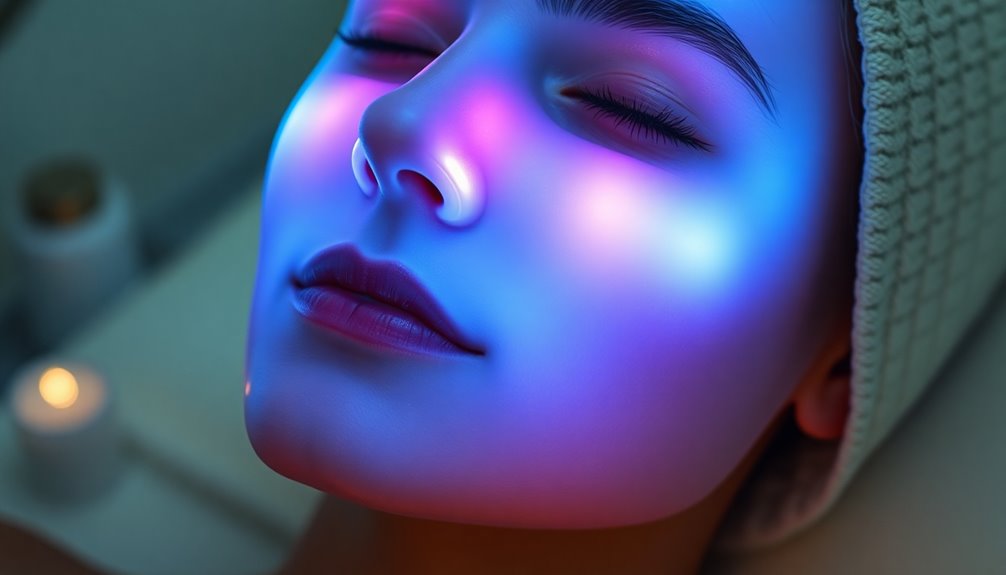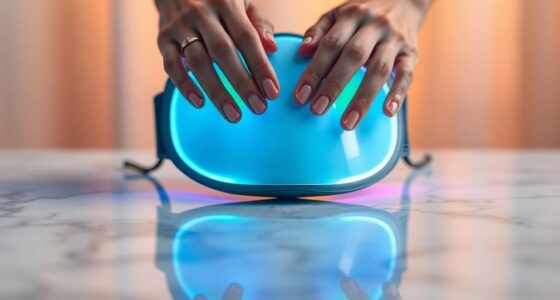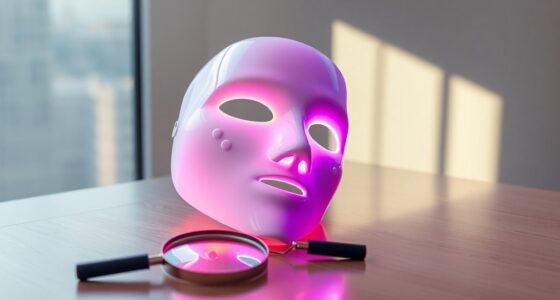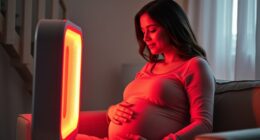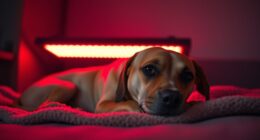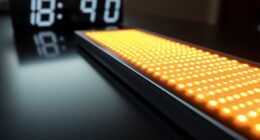LED face masks use light therapy to treat skin concerns like aging and acne. They emit different wavelengths; red light boosts collagen and reduces fine lines, while blue light targets acne-causing bacteria and soothes irritation. Safe for home use, these devices usually require consistent sessions to see results. You can enjoy your skincare routine without much hassle, and there’s more to discover about how these masks can fit into your regimen and enhance results.
Key Takeaways
- LED face masks use red light to stimulate collagen production, reducing signs of aging and improving skin texture.
- Blue light targets acne-causing bacteria, helping to reduce breakouts and balance oil production.
- Near-infrared light aids in wound healing and decreases chronic inflammation, promoting overall skin health.
- Regular use of LED masks enhances skin tone and texture, yielding visible improvements over time.
- These masks are generally safe, but eye protection is essential, especially during blue light therapy.
Overview of LED Face Masks

LED face masks are innovative devices that let you harness the power of light therapy right at home, targeting a range of skin concerns like wrinkles and acne.
These LED masks emit various wavelengths of light, such as red for anti-aging benefits and blue for combating acne-causing bacteria. Designed for comfort, they usually feature eye and mouth holes and secure with straps, so you can relax during treatment.
As non-invasive skincare treatments, they’ve become increasingly popular among beauty enthusiasts, reflecting a growing trend in at-home skincare solutions.
Prices vary widely, from under $50 to nearly $2,000, depending on the features and brand. With consistent use, you can enjoy clearer, more youthful skin without the need for invasive procedures.
Mechanism of Action

While you relax under the gentle glow of an LED face mask, light therapy works its magic by penetrating various layers of your skin.
LED light therapy utilizes specific wavelengths, like red light, to stimulate cellular activity and enhance collagen production. The red light, typically ranging from 630 to 700 nanometers, effectively reduces inflammation and promotes skin healing by boosting collagen and elastin synthesis.
Additionally, blue light targets acne-causing bacteria, helping to reduce blemishes and prevent future breakouts. Near-infrared light penetrates even deeper, aiding in wound healing and reducing chronic inflammation.
This therapy enhances blood circulation, facilitating nutrient delivery to skin cells and accelerating the recovery process, addressing various skin concerns effectively.
Benefits of Red Light Therapy

Red light therapy offers a multitude of benefits for your skin, making it a popular choice in the domain of skincare. This non-invasive treatment penetrates deeply to stimulate collagen production and elastin, essential for maintaining skin strength and elasticity.
By using red light therapy, you can effectively reduce signs of aging, such as fine lines and wrinkles, promoting a more youthful complexion. Additionally, it helps reduce inflammation, accelerating the healing process and improving overall skin texture.
Clinical studies have shown that regular use leads to visible improvements in skin tone. Integrating red light therapy into your skincare routine can enhance results, ensuring your skin looks vibrant and revitalized over time.
Benefits of Blue Light Therapy

If you’re struggling with acne, blue light therapy might be the solution you’ve been looking for. This innovative treatment specifically targets acne-causing bacteria on your skin, helping to reduce breakouts and promote clearer skin.
By penetrating the skin’s surface, blue light therapy reduces the activity of sebaceous glands, balancing oil production and preventing clogged pores. Studies show it can considerably decrease the number of inflammatory lesions associated with acne vulgaris.
Additionally, blue light helps soothe redness and irritation, improving your overall skin texture and appearance. Best of all, it’s a non-invasive treatment option, making it a convenient choice for managing acne without relying on harsh chemicals or invasive procedures.
Safety and Risks

Using blue light therapy through LED face masks can offer impressive benefits for acne treatment, but it’s important to understand the safety and risks involved.
Most LED face masks are deemed safe, as many have FDA clearance. However, potential side effects like irritation, redness, and increased inflammation can occur, especially if you don’t follow the manufacturer instructions.
Eye protection is vital, particularly with blue light exposure, so using blackout goggles is highly recommended. If you have light sensitivity or specific eye conditions, consult a dermatologist before starting treatment.
Remember, long-term safety data is still limited, making it essential to approach LED masks cautiously, especially if you have varying skin types or conditions.
Stay informed and prioritize your safety!
Effectiveness of At-Home Devices

When using at-home LED face masks, you might notice visible results over time, but consistency is key.
The quality of your device can greatly impact your experience, so choose wisely.
Visible Results Over Time
While at-home LED face masks can be a convenient addition to your skincare routine, achieving visible results takes time and commitment.
You’ll need to use your LED face mask consistently, often recommended for twice daily sessions lasting 30-60 minutes, to see those visible improvements in your skin. Regular use can lead to subtle enhancements in fine lines and wrinkles and boost collagen production over time.
However, it’s important to manage your expectations, as at-home devices may be less powerful than professional treatments. The cumulative effects of light therapy can take several weeks to months to show, so patience is key.
Stick with your routine, and you might just be pleasantly surprised by the results!
Device Quality Matters
The quality of your at-home LED face mask can greatly impact your skincare results. Effective devices often feature higher-quality components, leading to better outcomes. When considering a mask, check for FDA approval to guarantee you’re using a safe and effective product.
| Feature | Importance |
|---|---|
| Light Type | Red light (630-700 nm) is ideal for aging; blue light (415 nm) targets acne. |
| Device Quality | Higher quality often translates to better results. |
| FDA Approval | Guarantees safety and efficacy. |
Frequency of Use
Consistently using your at-home LED face mask is key to achieving noticeable skincare results. The frequency of use plays a significant role in the effectiveness of LED light therapy.
To maximize your results, consider these points:
- Follow the manufacturer’s guidelines, typically suggesting at least twice daily use.
- Each session should last between 30-60 minutes for ideal impact.
- Regular treatments lead to cumulative effects, enhancing skin texture and reducing wrinkles over time.
- Expect visible improvements, although they may be subtler compared to in-office treatments.
Recommendations for Use

To achieve the best results with LED face masks, it’s essential to stick to a regular schedule, using the mask for 20 to 60 minutes, two to three times a week.
Always follow the manufacturer’s instructions regarding treatment duration and frequency to avoid potential skin irritation. For safety, consider wearing eye protection, like blackout goggles, especially when using blue light.
Incorporating LED light therapy into your skincare routine can be beneficial, allowing you to apply makeup immediately after treatment without extensive aftercare.
If you have specific skin conditions, consult a dermatologist to tailor your use of LED light therapy and verify the mask suits your skin type.
This way, you’ll maximize the benefits while keeping your skin safe in the short term.
Future Trends in LED Light Therapy

As you explore the future of LED light therapy, keep an eye on emerging technologies that could expand its use beyond skincare.
With growing consumer awareness and demand, you might see more advanced home devices that enhance your experience and results.
Additionally, research into combining LED therapy with other treatments could reveal new benefits for various health fields.
Emerging Technologies in Therapy
While LED light therapy has primarily gained attention for its cosmetic benefits, emerging technologies are expanding its therapeutic applications, making it a promising avenue for future healthcare.
You’ll find that ongoing research is exploring new possibilities, focusing on enhancing user experience and efficacy in various fields.
Here are some exciting trends to watch for:
- Integration with other skincare modalities for better outcomes
- Advanced at-home LED devices tailored for user needs
- Optimization of specific wavelengths for different skin types
- Personalized treatment options based on individual conditions
As demand for non-invasive skin treatments grows, these innovations in LED light therapy might revolutionize how you approach skincare and overall well-being.
Expansion Into Other Fields
The potential of LED light therapy is rapidly expanding beyond cosmetic applications, opening doors to various fields such as pain management, wound healing, and even mental health.
Ongoing research is delving into its therapeutic applications, exploring how LED therapy can aid in wound healing and alleviate conditions like anxiety and depression. This non-invasive option is gaining traction as consumers seek effective treatments without the risks associated with surgery or invasive procedures.
Additionally, studies are focused on ensuring the safety and efficacy of LED therapy across diverse skin types, making it more accessible.
As technology advances, we can expect more sophisticated home-use devices, further integrating LED light therapy into everyday wellness routines.
Consumer Awareness and Demand
Consumer awareness of LED face masks is skyrocketing, driven by a growing interest in non-invasive skincare solutions. As you seek effective anti-aging solutions and acne treatments, the market is responding with a variety of FDA-approved options.
The rise in demand for at-home devices reflects a shift towards convenient skincare regimens.
Here are some key trends fueling this growth:
- Increased social media promotion and influencer endorsements
- Expanding research into LED light therapy for broader applications
- Innovations tailored to personalized skincare needs
- Emphasis on safety and efficacy in consumer choices
With these factors in play, it’s clear that LED face masks aren’t just a trend, but a pivotal part of the future of skincare.
Frequently Asked Questions
Do LED Face Masks Really Work?
When you’re wondering if LED face masks really work, it’s important to know that results can vary.
While some users see mild improvements in skin texture and wrinkles, at-home masks are generally less effective than professional treatments.
Factors like device quality, how often you use it, your age, and skin type all play a role.
How Often Should You Use a LED Face Mask?
You should use a LED face mask about 2 to 3 times a week for the best results. Each session should last around 20 to 30 minutes.
If you’re targeting specific issues like acne, you might consider daily use, but be sure to stick to the manufacturer’s guidelines.
Consistency is essential, so give your skin time to recover by allowing at least 24 hours between sessions to maximize the benefits.
What Do the Different Colors on a LED Face Mask Do?
Imagine your skin as a canvas, with each color of light acting like a brushstroke.
When you use a LED face mask, red light boosts collagen and reduces wrinkles, while blue light zaps acne-causing bacteria.
Yellow light enhances circulation for a smoother texture, and green light targets dark spots to even out your tone.
Near-infrared light dives deep, promoting healing and reducing inflammation.
Each color plays a unique role in achieving glowing skin.
What Are the Disadvantages of a LED Mask?
When considering LED masks, you should be aware of several disadvantages. You might experience subtle improvements in skin texture and wrinkles, but they may not be as noticeable compared to professional treatments.
Overuse can lead to irritation, redness, or pain. Plus, the long-term safety of these devices isn’t well-established, and effectiveness can vary based on device quality and your skin type.
If you have darker skin, discoloration risks are higher, so proceed with caution.
Conclusion
To sum up, LED face masks can be a game-changer for your skincare routine. By harnessing the power of red and blue light therapies, they tackle various skin issues effectively. Just like a knight wielding a sword in battle, these masks can help you fight against aging and acne. As you incorporate them into your regimen, remember to stay consistent for the best results. With ongoing advancements, the future of LED therapy looks bright, so don’t miss out!
